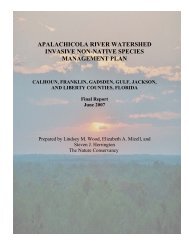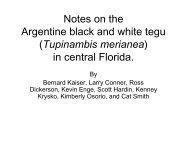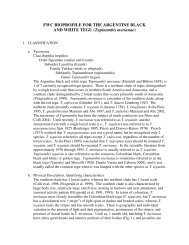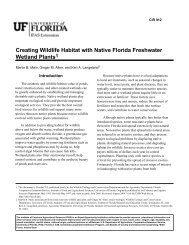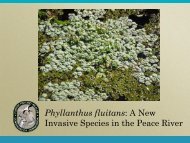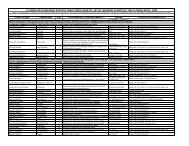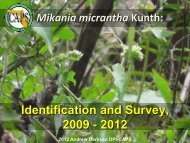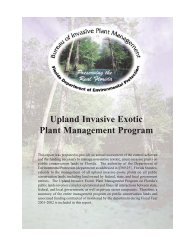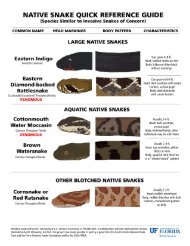Identification Guide For Invasive Exotic Plants of the Florida Keys
Identification Guide For Invasive Exotic Plants of the Florida Keys
Identification Guide For Invasive Exotic Plants of the Florida Keys
You also want an ePaper? Increase the reach of your titles
YUMPU automatically turns print PDFs into web optimized ePapers that Google loves.
Scientific Name:<br />
Common Name(s):<br />
Panicum repens<br />
Torpedo grass, Quack grass, Bullet grass<br />
Height:<br />
Leaves:<br />
Flowers:<br />
Bark:<br />
Fruit:<br />
O<strong>the</strong>r:<br />
Treatment:<br />
Up to three feet<br />
Upper leaf sheaths are glabrous or hairy. Leaf blades are stiff, linear, flat or<br />
folded, reaching ten inches in length and <strong>of</strong>ten having surfaces with a whitish<br />
waxy coating.<br />
Inflorescence is three to nine inches long with erect branches. Flowers nearly<br />
all year<br />
N/A<br />
Grass seeds<br />
Perennial grass with sharp, torpedo-like growing tips. Tolerant <strong>of</strong> drought<br />
and partial shade, but ideally suited to moist to wet sandy or organic soils.<br />
Reproduces principally via rhizomes.<br />
Foliar with high concentration <strong>of</strong> Rodeo<br />
APIRS- http://aquat1.ifas.edu<br />
<strong>Identification</strong> & Biology <strong>of</strong> Non-Native <strong>Plants</strong> in<br />
<strong>Florida</strong>’s Natural Areas by K.A Langeland, K.<br />
Craddock Burks<br />
31



